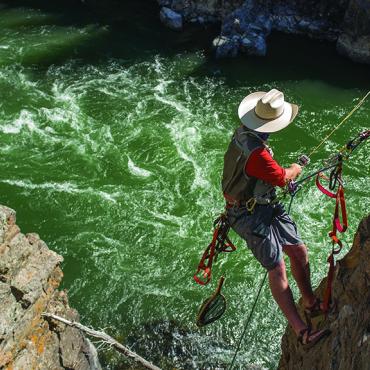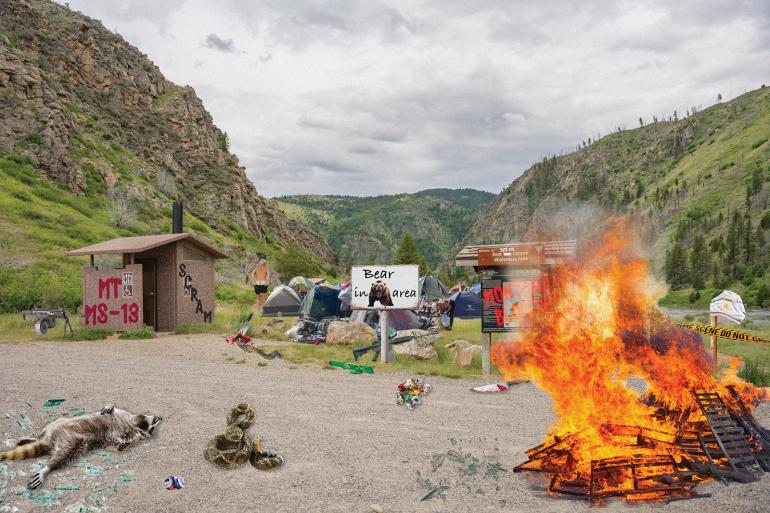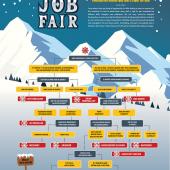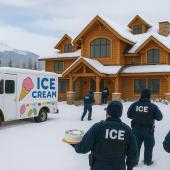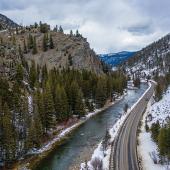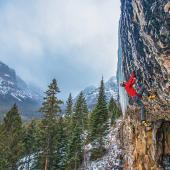Ugly by Design
A new way to protect the Montana lifestyle.
When longtime Bozemanite Joseph Bloe pulled into the Sourdough trailhead early one Saturday morning, he found the parking lot unrecognizable. Dilapidated tents were pitched in parking spaces, the stench of human waste lingered in the air, and a hand-painted sign warned: DANGER: ACTIVE BEAR-MAULING ZONE. Beside it, a faded pair of stained tighty-whiteys flapped triumphantly from a wooden stake—the unofficial flag of Montana’s newest nonconformist movement. “Welcome to SCRAM territory, pretty boy,” said a voice inside the nearest tent. “Why don’t you come inside and get a taste!”
The signs of over-growth in Gallatin County are everywhere: busy streets, rush-hour traffic, crowded access sites, skyrocketing home prices, and high-dollar construction on every corner. Bozeman is booming, and while the influx has boosted the local economy (and, some admit, diversified the dating pool), many longtime residents have finally had enough.
In response, members of various local conservation groups have joined forces to form the Strategic Committee on Resource Abuse and Mismanagement (SCRAM). At first, they tried to slow Bozeman’s growth through traditional channels—town-hall meetings, zoning proposals, policy reports. But after months of failure, the committee’s mission took a more creative and unsightly approach.
Restoration costs money. But degradation’s cheap as hell. We get most of our stuff for free by scavenging the urban-camping areas around Bozeman. —Gray Tergood
“Darn straight it did,” says committee chair Dee Graider. “Nobody complains about the crowds or home prices in Detroit, and that’s for one reason: it’s ugly.”
Rather than attempting to mitigate the effects of remote workers and wealthy newcomers, SCRAM decided to weaponize Montana’s worst qualities. The new plan? Intentionally depreciate the area’s most iconic landscapes and amenities to the point where no outsider would ever want to come for a visit, let alone live here.
“It hit me last winter, when a few friends of mine were talking about how that Yellowstone show that brought all those Californians and Texans here,” explains Graider. “We can’t erase what they saw on TV, but we can make sure that what they find when they get here is the most run-down, foul-smelling, horror-inducing disappointment imaginable.”
And so began SCRAM’s campaign of “Ethical Land Desecration.”
Every month, SCRAM board members gather in undisclosed locations to identify once-beloved, now-overrun trailheads, parks, and scenic overlooks in need of some “aesthetic disincentivizing.” Between meetings, members are tasked with sourcing ideas, funds, and materials for the next round of sabotage. Tactics range from the basic—graffiti, overflowing trash cans, animal carcasses—to the more elaborate and unconventional.
“We’re getting grizzly scat from the zoos, forging ‘MS-13 Territory’ signs, and planting mounted rattlesnakes,” says Lee Terbug, SCRAM’s Director of Destruction. “Last week, we 3D-printed fake hypodermic needles and scattered them around body chalk outlines at Sourdough.”
Terbug recently discovered that his own neighbor hadn’t been to Hyalite in weeks due to overcrowding. “I told her, ‘Go Saturday.’ On Friday night, I went up there and trashed the place,” he says, with a proud grin. “Broken glass, fake feces, dirty underwear, strategically positioned roadkill, the whole nine yards. The next day, she had the reservoir to herself.”
SCRAM’s newest initiative is the formation of the Wreckreators, an elite squad of land-degradation specialists, described internally as “the Navy SEALs of backcountry sabotage.” Their tactics are modeled more after guerrilla theater than conservation policy; they’ve hired out-of-work method actors to pose as hostile vagrants at trailheads and developed an “Urban Camper Deployment Kit” complete with fake tents, odor packs (e.g., Dumpster After Rain), and hand-lettered protest signs with catchy mantras such as This Land Is Stolen—But I’m Keeping It.
To broaden public participation, SCRAM now offers free DIY (Degrade-It-Yourself) starter boxes that include spray paint & stencils, rattlesnake-sound-generators, Rabid Wolves In Area warning signs, faux dirty needles, and the iconic SCRAM bum flag—a crusty pair of stained briefs complete with collapsible pole mount.
We can’t erase what they saw on TV, but we can make sure that what they find when they get here is the most run-down, foul-smelling, horror-inducing disappointment imaginable. —Dee Grader
Jess T. Fide, a former MSU sociology professor and current SCRAM board member, defends the group’s unconventional methods. “Ethics are flexible,” she explains, “and morality is relative. Chicanery, devilry, and subterfuge have been used throughout history to obtain noble ends.” Fide moved here seven years ago “for healing after heartbreak” and swears she’s ultimately an ethical land user. “I love this place,” she says. “And I’m not opposed to transplants in general—just the jackasses. To get rid of them, I think the ends justify the means.”
Still, not everyone is on board. Skip Tickle, a longtime conservationist with the Gallatin Natural Resource Council, is one of SCRAM’s most vocal critics. “When Dee told me about the group, I thought it was just an act,” he says. “Then I saw the hacked Visit Montana website showing pictures of Laurel and the Berkeley Pit. They also changed the slogan to “Big Sty Country,” and I thought, Oh God, they’re serious.
Indeed, hackers affiliated with SCRAM infiltrated state tourism platforms, replacing scenic views with drone footage of oil refineries, strip mines, and freshly clearcut hillsides. Additionally, SCRAM’s volunteer social-media team has been featuring anti-tourism slogans such as Montana: The First Worst Place. Another, We Hear North Dakota Is Nice, has gained significant traction and even earned SCRAM a tentative $40,000 grant from the North Dakota Tourism Board. “We don’t really support their mission,” notes North Dakota’s PR director Val Udaflats, “but you know what they say: there’s no such thing as bad press.”
Tactics for dissuading out-of-staters from moving to Montana range from the basic—graffiti, overflowing trash cans, animal carcasses—to the more elaborate and unconventional.
SCRAM’s funding is completely crowdsourced and has mostly come from bake sales, 50/50 raffles, and the occasional anonymous donation to their GoFundMe page (rumored to come from embittered exes of local realtors, to hinder their business). While all of the group’s applications for city and county funding were denied early in the process, SCRAM founding member Gray Tergood isn’t worried.
“Restoration costs money. But degradation’s cheap as hell,” says Tergood. “We get most of our stuff for free, by scavenging the urban-camping areas around Bozeman. Shoot, our biggest expense last month was six jars of Nutella.”
Still, the group sees itself as a vigilante band of unlikely heroes. “At the end of the day, we’re preserving Montana by making it uninhabitable,” says Tergood. “If that’s not conservation, what is?”
If you’re interested in supporting SCRAM or learning more about their initiatives, visit scram.org.


